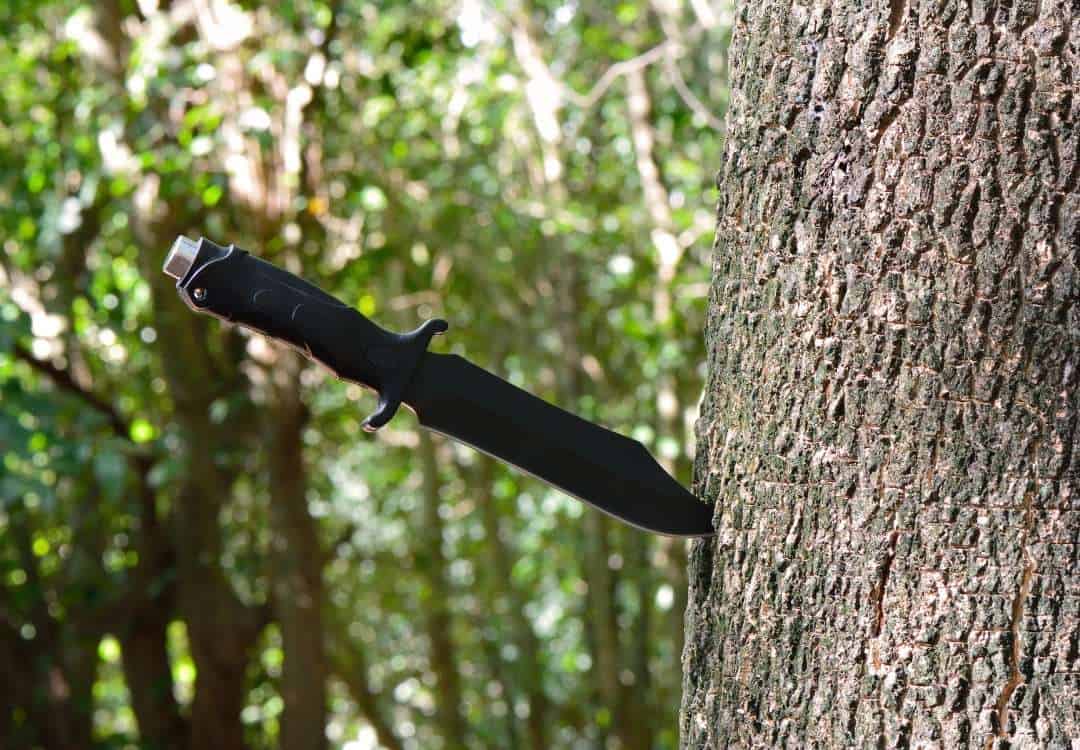Canada-wide flat shipping $9.99 | Free shipping for orders over $100
Estimated reading time: 6 minutes
A knife is the most important tool that you can have in a survival situation on foot or horseback. When a knife is needed, nothing else can substitute for the versatility of a sturdy blade, and it is one of the few tools that cannot be improvised when you are stuck in the woods.
A good survival knife will help build a fire, make a shelter, prepare food, and perform first aid. It must also be able to cut nearly anything! It is your go-to tool in the wilderness. Treat your knife well, and it can turn the worst day of your life into your best story ever.
But the choices of knives are endless! From Swiss Army knives to machetes as long as a sword, what is the best knife for a trail rider?
Let’s start with knife basics!


Great! Now that we are talking the same language let’s talk about what features we need as trail riders.
Spoilers: I would never bring the knife pictured above.
Can you guess why? We will look at the features of an ideal bushcraft knife and discover where this knife falls short.
Let’s start by making a few general assumptions:
With that in mind, you will not likely be using your knife for hunting or trapping. Instead, the knife that you need will be for Camp Crafts. Doesn’t that sound fun? Well, not if you are a knife. Nothing is harder on a blade than Camp Crafts, so let’s find out what kind of blade is up to this rough work.
My top pick for a Camp Craft survival knife is the ESEE 5.
At $236 CDN, this is an excellent knife that checks all the boxes. Whatever knife you choose, try to find one that has as many of these features as possible:
The first thing you should notice is that it is bright orange! We are not pretending to be commandos here! If you ever drop or lose your knife (especially after nightfall), you will be pleased that you have an ugly bright coloured knife and not a commando black one.
The next most important feature is the full tang as seen below. The tang is the portion on the blade that extends inside of the handle. A full tang knife will have a single piece of metal from point to pommel; this significantly increases the knife’s overall strength.

A thick, strong blade is another critical feature. The EESE 5 blade is made of 1095 Carbon Steel (typical for knives) and is almost 5 mm thick. This construction is a crucial feature for a technique called batoning that we will cover in later articles on fire building. If you want to skip ahead, here is a video on batoning.
The EESE 5’s standard sheath can be worn vertically from your belt, or for a little extra; you can get the Molle Sheath so that you can wear it horizontally and out of the way. As riders, this can be critical since you don’t want anything rubbing your leg as you ride. The EESE 5 sheath can also be easily adjusted to be worn on your left or right side, so it is perfect for all the South Paws out there.
The knife is entirely modular and comes apart into three pieces (plus hardware). So if you damage the blade or accidentally break the handle, you can order the broken piece and repair it yourself. The handle is textured and well contoured to fill the palm of your hand, which increases hand strength and resists slipping, even when wet.
With these points in mind, let’s look again at the first knife and why I would avoid using it as a survival knife.
TIP: Avoid foldable blades for this exact reason. They are easy to store but will often break.
Regardless of what knife you choose, it needs to get the job done. Choose a simple, reliable survival knife that you can keep on you every time you go to the barn. Check out this blog post for other items that you should always have on you when you hit the trails.
With luck, you will only use it to cut bailing twine, but if you ever need to cut your reins free in an emergency or prepare firewood, you will be thankful that you had the foresight to buy a reliable blade.
Treat your blade well, maintain it when it’s not in use, and keep it on you!
You are only as sharp as your knife.

2 Responses
Thank you for this important information!
You’re welcome!